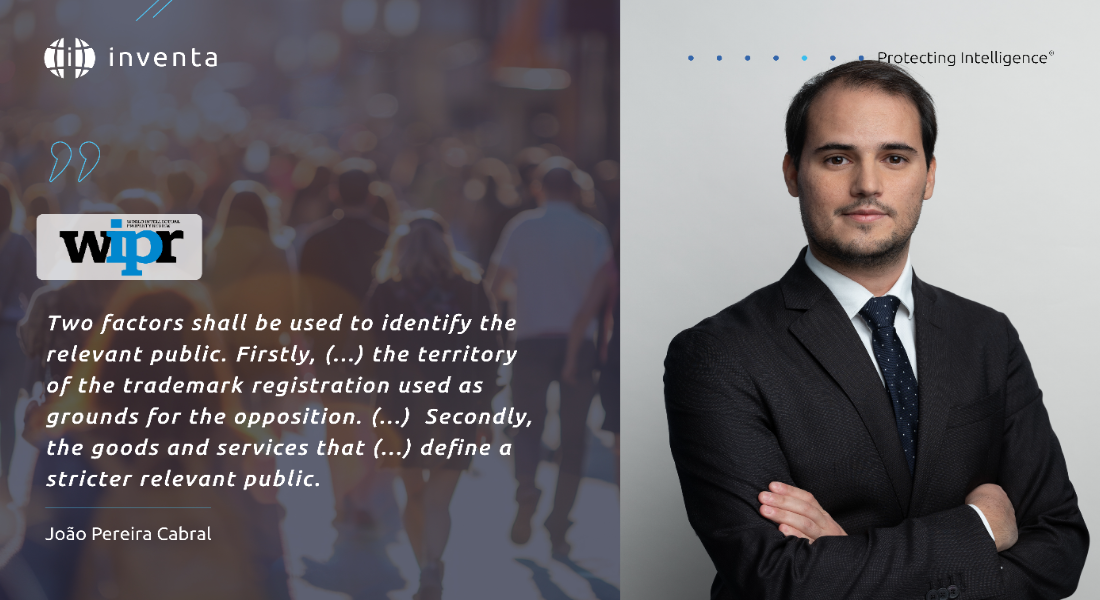
Tourism’s influence on defining the ‘relevant public’ in EUTM oppositions
Likelihood of confusion is by far the most used ground for refusal in oppositions against European Union trademark (EUTM) applications.
It exists if there is a risk that the relevant public might believe that the goods or services in question come from the same undertaking or economically linked undertakings. Consequently, the ‘relevant public’ concept is a determinant for assessing the relative ground for refusal.
Since tourism is a very relevant industry in some EU countries, it can only be concluded that tourists are part of the public. The aim of this article is to reflect on to what extent tourism impacts the notion of relevant public.
The importance of the relevant public in the comparison of trademarks
The notion of relevant public is determinant in relation to several aspects of the assessment of risk of confusion.
One of them is in the comparison of the signs. The meaning or pronunciation of a word may vary depending on the relevant public.
If a trademark consists of a Portuguese word, its meaning will be understood by the Portuguese consumers but not by the French.
If another trademark consisting of a different word but with the same meaning in Portuguese is applied for registration in the EU, it will be conceptually similar for the Portuguese consumers, who will understand the meaning of both trademarks, but not for the French consumers.
Similarly, the relevant public is also a decisive factor when assessing the inherent distinctiveness of word elements in a trademark. A word mark consisting of the words “Sumo de maçã” will be inherently distinctive for French consumers in relation to apple juices but will not for Portuguese consumers, as it means “apple juice”.
Identifying the relevant consumer
Two factors shall be used to identify the relevant public. Firstly, it shall be taken into account the territory of the trademark registration used as grounds for the opposition. If the earlier registration is a national trademark, then the relevant public shall be the public that can be found in that country. Secondly, the goods and services that are identical or similar shall be used to define a stricter relevant public.
Likelihood of confusion is always assessed based on the perception of the consumers of the goods and services that have been found identical or similar. Depending on the goods or services, the relevant public is the general public or a professional/specialised public. Then, if it is concluded that a significant part of the relevant public may be confused regarding the origin of the goods, there will be likelihood of confusion.
As seen, the first step for defining the relevant public is to define the relevant territory. If the earlier trademark is, for example, a Portuguese trademark, then the relevant territory is Portugal and, consequently, the relevant public is the one that can be found in Portugal.
This usually means that the relevant language will be the Portuguese. However, if Portugal has a high number of tourists in proportion to its population can the Portuguese be the only relevant language?
Usually, it is considered that most used English words are understood by the Portuguese consumers of certain goods and services. But what about other languages? What about the inverse situation, of the tourists that do not understand Portuguese?
To address these questions, the second step shall be taken. The goods and services at issue shall be considered. If the services in question are related to tourism, such as temporary accommodation or international travelling, it should be concluded that most of the relevant public is not Portuguese nor understands Portuguese.
For tourism-related services, it shall be analysed which languages are used in a level that may be considered significant inside the relevant public already identified. Continuing the example, if half of the tourists in Portugal were Spanish, then Spanish should be considered a relevant language when assessing the likelihood of confusion.
If an EUTM application for tourism-related services covers a trademark that has a meaning in Spanish that is the same to that of an earlier Portuguese registration used as grounds for opposition, then it shall be concluded that they are conceptually similar, as the significant part of the relevant consumer, the Spanish tourists in Portugal, will understand the similar meaning of the trademarks.
However, the case will not be so clear if the percentage of the relevant consumer is not that high. Following the same example, but if instead of Spanish tourists we think of German tourists in Portugal, should 8% be considered a significant part of the relevant public and, therefore, possible conceptual similarities in German be considered, even if the earlier registration is Portuguese?
The inverse is also to be considered. If the percentage of Portuguese consumers of tourism related services in Portugal would be less than half, then it would be irrelevant that a certain word was not distinctive in Portuguese.
In this case, if more than half of the relevant public does not understand Portuguese and does not see the word as being descriptive, then a significant part of the relevant public will confuse the trademarks that bear that word (descriptive only in Portuguese).
The situation is also less clear when the goods and services are not tourism-related services. Regarding these goods and services, in Portugal, if they are aimed to the general public, the number of tourists that are part of the relevant public will most likely not be deemed significant against the Portuguese population.
Tourism is relevant for assessing the relevant public. This is clear when considering tourism related services. It may also be relevant in relation to goods and services targeting the general public if the number of tourists who may confuse the signs is significant.
It is not easy to set the limit above which a number of people becomes a significant part of the relevant public. However, it is clear that EU trademark practice has to take into account the tourists (and analogously the number of people who work and live abroad) to define the relevant public when assessing the risk of confusion between trademarks.
This is a co-published article, which was originally published in the World Intellectual Property Review (WIPR).
Lista de Territórios
Não existem resultados para a sua pesquisa.
- África
- África do Sul
- Angola
- Argélia
- Benin
- Botsuana
- Burkina Faso
- Burundi
- Cabo Verde
- Camarões
- Chade
- Comores
- Costa do Marfim
- Djibuti
- Egito
- Eritreia
- Eswatini (Suazilândia)
- Etiópia
- Gabão
- Gâmbia
- Gana
- Guiné
- Guiné-Bissau
- Guiné-Equatorial
- Lesoto
- Libéria
- Libia
- Madagáscar
- Maiote
- Malaui
- Máli
- Marrocos
- Maurícias
- Mauritânia
- Moçambique
- Namíbia
- Níger
- Nigéria
- Quénia
- República Centro-Africana
- República Democrática do Congo
- República do Congo
- Reunião
- Ruanda
- Saara Ocidental
- São Tomé e Principe
- Seicheles
- Senegal
- Serra Leoa
- Somália
- Sudão
- Sudão do Sul
- Tanzânia
- Togo
- Tunísia
- Uganda
- Zâmbia
- Zanzibar
- Zimbábue
- África (OAPI)
- África (ARIPO)
- Mais Territórios
- Macau
- Maldivas
- Portugal
- Timor Leste
- Marca da União Europeia (EUIPO)
- Marca Internacional (Sistema de Madrid)
- Patente Europeia (IEP)
- Tratado de Cooperação em matéria de Patentes (PCT)




